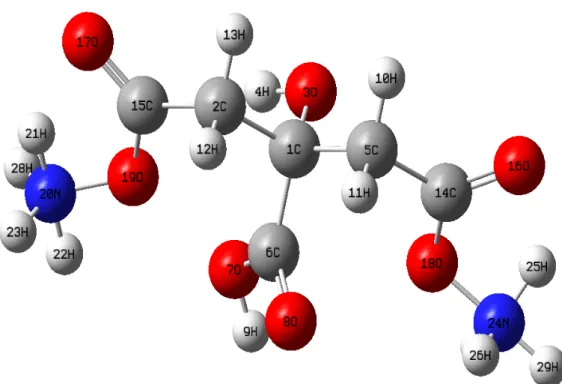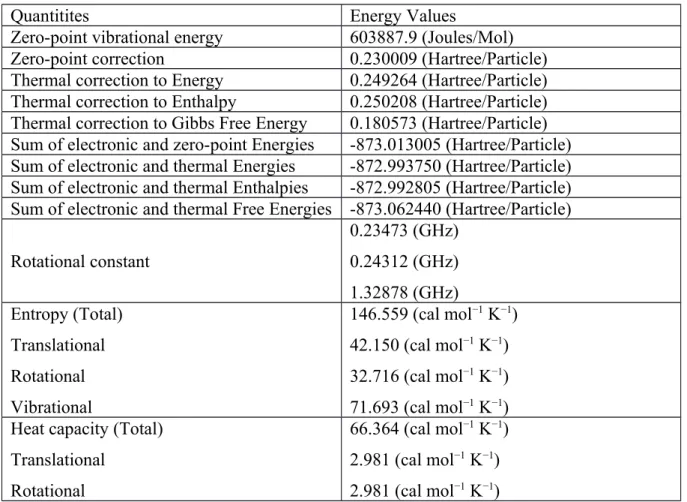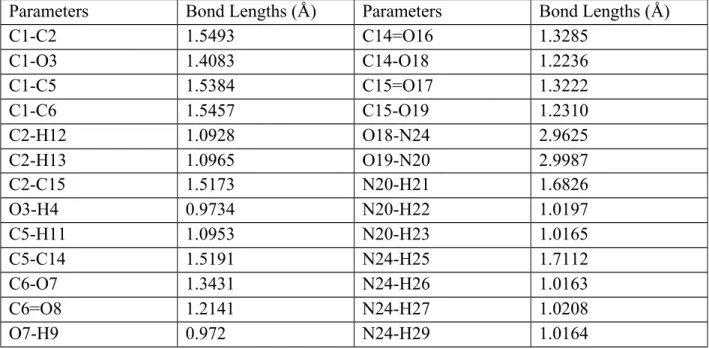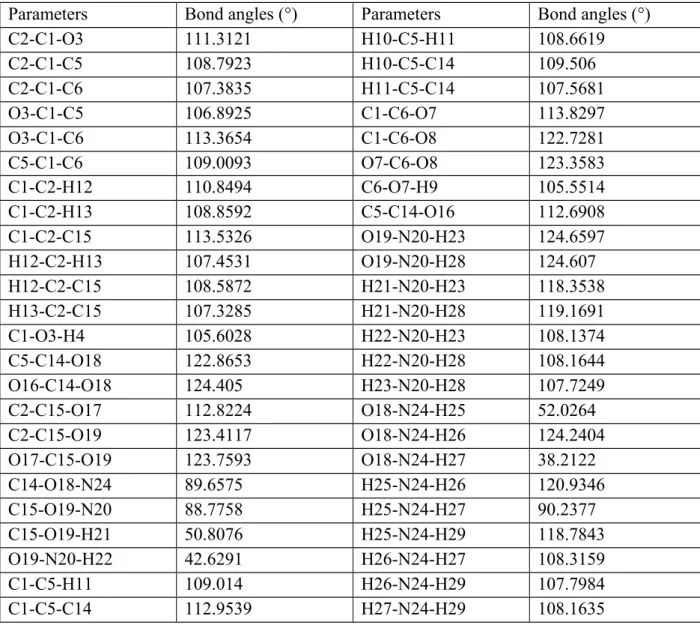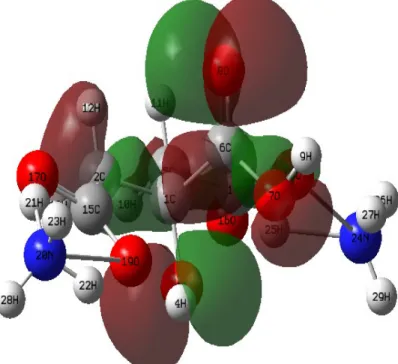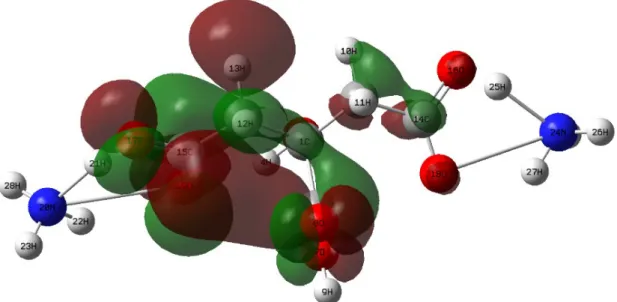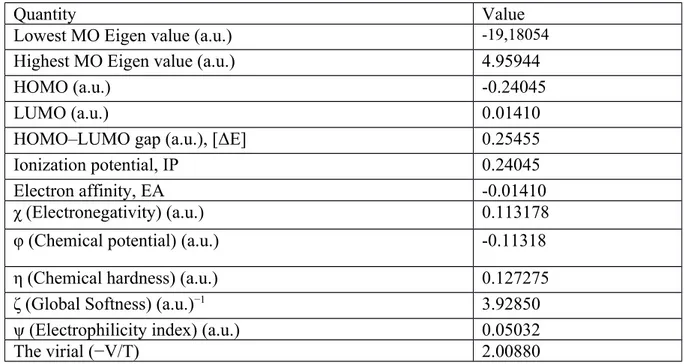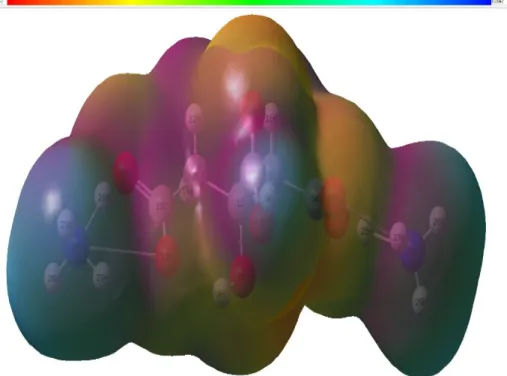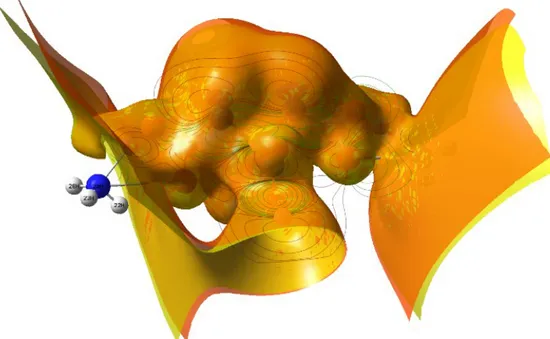Araştırma Makalesi
Theoretical Examinations of Diammonium Hydrogen Citrate Compound by Density
Functional Theory Method at B3LYP/6-31G(d,p) Level of Theory Asaf Tolga ULGEN 1*, Tahsin TURGAY 2, Bahattin AKKURT 3, Gurcan YILDIRIM 3
1Sirnak University, Department of Electric-Electronic Engineering, Sirnak–Turkey, 73000 2Sakarya University, Department of Architecture, Sakarya–Turkey, 54187
3Abant İzzet Baysal University, Department of Mechanical Engineering, Bolu–Turkey, 14280
* Corresponding Autor; ulgen_at@sirnak.edu.tr;
Gönderme tarihi: 27/07/2019 Kabul tarihi: 29/12/2019
ABSTRACT
This study aims to point out a strong strategy between the fundamental characteristic features as regards such as chemical reactivity, stable, electronic acceptor ability, bioactivity, kinetic stability, polarizability and intramolecular charge transfer regions, and the potential application fields of the diammonium hydrogen citrate compound by means of theoretical findings founded on density functional theory (DFT) method at the standard B3LYP/6-31G(d,p) calculation level for the first time. In this respect, we determine the optimized molecular structures, total energies, atomic charges, thermodynamic constants, lowest unoccupied molecular orbital (LUMO), highest occupied molecular orbital (HOMO), electrostatic potential surface map (MEP), molecular electrostatic potential (ESP) contour map and evaluated data (band-gap energy, chemical hardness, global softness, electronegativity, chemical potential and electrophilicity index parameters) for the diammonium hydrogen citrate molecule. According to the results obtained, non-uniform charge distribution is observed on the various atoms, leading to both the electrophilic (electronegative) and nucleophilic (electronic donor ability) regions in the structure. Hence, the molecule can be not only bonded metallically but interacted intermolecularly. Moreover, it is found that the atomic position in the skeleton of compound plays an important role on the electron engagements, conjugative effects, strong intra-molecular charge transfer regions, valence electron cloud effects and σ-bonds between the atoms in the diammonium hydrogen citrate.
Keywords: Diammonium hydrogen citrate; B3LYP/6-31G(d,p) Calculation level; Electrophilic; Nucleophilic
Diamonyum Hidrojen Sitrat Bileşiğinin B3lyp / 6-31g (D, P) Teorisi Düzeyinde Yoğunluk Fonksiyonel Teori Yöntemiyle İncelenmesi
ÖZET
Bu çalışmada kimyasal reaktivite, kararlı, elektronik alıcı yeteneği, biyoaktivite, kinetik stabilite, polarize edilebilirlik ve intramoleküler yük aktarma bölgeleri ve diamonyum hidrojen sitrat bileşiğinin potansiyel uygulama alanları gibi temel karakteristik özellikler arasında güçlü bir stratejiye işaret etmeyi amaçlamakta ve standart B3LYP / 6-31G (d, p) hesaplama düzeyinde yoğunluk fonksiyonel teorisi (DFT) yöntemi üzerine kurulan teorik bulgular vasıtasıyla incelenmiştir. Bu bağlamda, optimize edilmiş moleküler yapıları, toplam enerjileri, atom yüklerini, termodinamik sabitleri, en düşük boş moleküler orbital (LUMO), en yüksek işgal edilmiş moleküler orbital (HOMO), elektrostatik potansiyel yüzey haritası (MEP), moleküler elektrostatik potansiyelleri (ESP), diamonyum hidrojen sitrat molekülü için dağılım haritası ve değerlendirilmiş verileri (bant aralığı enerjisi, kimyasal sertlik, küresel yumuşaklık, elektronegatiflik, kimyasal potansiyel ve elektrofiliklik indeksi parametreleri) belirlendi. Elde edilen sonuçlara göre, yapıdaki hem elektrofilik (elektronegatif) hem de nükleofilik (elektronik donör yeteneği) bölgelere yol açan çeşitli atomlarda düzgün olmayan yük dağılımı gözlenmiştir. Dolayısıyla, moleküller arası etkileşime girebiliyor olsada molekül sadece metalik olarak bağlanabilir, yinede bileşiğin iskeletindeki atom pozisyonunun, elektron bağları, konjuge etkiler, güçlü moleküler içi yük transfer bölgeleri, değerlik elektron bulutu etkileri ve diamonyum hidrojen sitrattaki atomlar arasındaki σ-bağları üzerinde önemli bir rol oynadığı bulunmuştur.
Anahtar Kelimeler: Diamonyum hidrojen sitrat, B3LYP / 6-31G, Nükleofilik bölge, MEP ve ESP.
1. INTRODUCTION
As well-known that citrate is the derivative of a weakorganic acid (called as citric acid with the chemical formula of C6H8O7) and is a white (but generally colorless), odourless and crystalline solid. The citric acid occurs naturally in citrus fruits and takes place into stronger edible acid parents. Thus, the acid (presenting the antioxidant characteristics) can easily be used in the application fields of culinary, cosmetics, pharmaceuticals, dietary supplements, flavoring and preservative in foods and beverages as regards soft drinks and candies (Frank, 2005). Furthermore, when adding into the ice cream the compound behaves as the emulsifying agent to prevent the sucrose crystallization. It enables the basic dyes to balance the pH level so that the citric acid can be used in food coloring applications.
Besides, with the excellent chelating agent the compound is preferred to use in the technology for the effectiveness of soaps and laundry detergents in the bathroom and kitchen cleaning solutions. In fact, one can see the compound or its derivatives in the industrial application for the dissolve of rust from steel and passivation of stainless steels. Moreover, the
citrate is produced by the deprotonation process of three carboxy groups (known as tricarboxylic acid trianion) in the citric acid. Citrate and its derivatives take several important places in the potential application fields due to its valuable characteristic properties. In more detail, the citrates (salts of citric acid) can be used as anticoagulants in the potential application areas. For example, the citrates with the quality buffering features can control the level of pH in the household cleaners and pharmaceuticals due to the acidulant performances. The compound maintaining the stability of active ingredients is used as a preservative, antimicrobial agent, fundamental metabolite and food acidity regulator. Similarly, the compound takes several places in medicine areas as a result of its intrinsic characteristic anticoagulant properties by chelating calcium in blood.
As for the derivatives of citrate, the disodium citrate is one of the most abundant materials used in the potential application fields. The compound helps the adjacent materials to develop the positive effects of other antioxidants, and thus is used as an acidity regulator, sequestrant and antioxidant in the food products such as the carbonated beverages, processed cheeses, gelatin, sweets, wines, jams, ice creams and milk powders. Additionally, these kinds of materials can be observed to use in the medicines (in the fields of urinary acidosis, urinary tract infections, burning micturition, kidney stones and in adjunctive therapy with sulphonamides) as a urinary alkalizer. The other compound, diammonium hydrogen citrate, is a derivative of citrate commonly used in the industry. Especially, the compound of diammonium hydrogen citrate (with the chemical formula of C6H14N2O7) is preferred to use as the carbon source in especially the technological application arenas over the worldwide. For example, Zhang et al used to the diammonium hydrogen citrate compound to rapidly produce the qualified N-doped photoluminescent carbon nanodots (exhibiting the superior optical performances) by means of one-step microwave irradiation method (Srivastava, 2017). Moreover, Nair et al (from Department of Chemistry, Indian Institute of Space Science and Technology in India) proposed that the diammonium hydrogen citrate obtained the positive effect on the calcination temperature of MgO materials in the year of 2019 (Nair et al., 2019). Another scientific study published by Khan et al synthesized the green-emitting carbon dots with the high ratio of luminescence using a starting material of diammonium hydrogen citrate (Khan et al., 2017). A scientific paper entitled “Optimization of d-lactic acid production using unutilized biomass as substrates by multiple parallel fermentation” presented that the diammonium hydrogen citrate was used to identify the optimal concentration for D-lactic acid production (Mufidah and Wakayama, 2016). Also, the diammonium hydrogen citrate is used as dispersant to point out the quality factors (founded on the deflocculation and
stabilization) of ceramics after sintering in colloidal processing of Ti3SiC2 compounds (Idzkowska et al., 2015). Similarly, Dunn et al displayed that the usage of diammonium hydrogen citrate with the matrix 2',4',6'-trihydroxyacetophenone led to enhance remarkably the detection of phosphorylated peptides from digests of beta-casein and ovalbumin (Dunn et al., 2006). According to the scientific study performed in China, the diammonium hydrogen citrate plays an important role on the formation of Three-dimensional hierarchical silver nanomaterials prepared by a simple surfactant-free wet-chemical method at room temperature (Huang and Zhu, 2014). In the literature, it is also possible encounter the diammonium hydrogen citrate compound as the effective ionization-assisting reagent (such as the adjacent of iron oxide nanoparticles) in the mass spectrometry (Taira et al., 2006). One can see the diammonium hydrogen citrate and derivatives in several application fields (Berlinger et al., 2009; Dunn and Allison, 2007; Zhang et al., 2006). In this regard, whereas there are a number of experimental studies and theoretical approaches focused on the diammonium hydrogen citrate compounds as mentioned above.
Nowadays, the researchers are especially interested in the theoretical-based studies so that they predict the fundamental characteristics (namely; structural, spectral, optical and electrochemical) of compound economically and explain some experiment phenomena insightfully (Soykan et al., 2013; Durig et al., 2009; Sun et al., 2010). In particularly, the researchers prefer to calculate the fundamental characteristics by means of Density functional theory (DFT) based on the Becke's three parameter hybrid exchange functional combined with the Lee-Yang-Parr non-local correlation function level of theory (Breda et al., 2008; Foresman and Frisch, 1996). This is because, the electron correlation recovers the self-consistent Kohn-Sham along with the electron density functions (Scott and Radom, 1996; Durig et al., 2011), and the DFT level of theory displays much more effective and reliable results.
In the current work, the fundamental properties including the optimized molecular structures, total energies, atomic charges, thermodynamic constants and molecular frontier orbital energies (lowest unoccupied molecular orbital, highest occupied molecular orbital, electrostatic potential surface, molecular electrostatic potential contour maps, surface maps and related findings such as the chemical hardness, softness, electronegativity, chemical potential and electrophilicity index) of diammonium hydrogen citrate molecule are thoroughly computed by the DFT method at the B3LYP/6-31G(d,p) level of theory in detail for the first time. It is found that all the calculated results are found to be in good agreement with the available experimental data. On this basis, the B3LYP/6-31G(d,p) calculation level in the
study plays an important role in understanding of dynamics of diammonium hydrogen citrate molecule.
2. CALCULATION METHODS FOR DIAMMONIUM HYDROGEN CITRATE MOLECULE
In this paper, we perform all the calculations including the optimized molecular structures, total energies, atomic charges, thermodynamic constants, lowest unoccupied molecular orbital, highest occupied molecular orbital, electrostatic potential surface, molecular electrostatic potential contour maps, surface maps and related findings such as the optical band-gap energy, chemical hardness, softness, electronegativity, chemical potential and electrophilicity index) of diammonium hydrogen citrate molecule with the assistant of the density functional theory (abbreviated as DFT) with the Becke’s hybrid functional three-parameter for the exchange part and correlation function proposed by Lee-Yang-Parr (LYP) at 6-31G(d,p) level of theory (Miehlich et al., 1989; Palafox et al., 2007; Handy et al., 1992; Frisch et al., 2010; Kohn and Sham, 1965; Becke, 1993; Lee et al., 1988). Before the characterization studies of diammonium hydrogen citrate compound, we calculate the minimum stationary points of low-energy structures by means of the detailed potential energy surface scans between some groups and some dihedral angles at the B3LYP/6-31G(d,p) basis set so that we define the most steady-state of diammonium hydrogen citrate compound. Namely, we describe the hydrogen bonding interaction, hydrogen atom transferring, and long-range electrostatic interactions founded on the hydrogen atom positions and orientations throughout the compound (Jaronczyk and Dobrowolski, 2008). This is well-known that the most steady-state of a molecule maximizes the attractive intra-molecular interactions whereas the repulsive intra-molecular interactions are minimized. One can see the energetically most stable (optimum) crystal structure of diammonium hydrogen citrate molecule in Fig. 1. Thus, we compute the fundamental characteristic features provided above for the most steady-state form of molecule to get much more reliable results. It is to be mentioned here that the theoretical force constants are determined from the optimized-geometry structure under C1 point group. In the current work, the zero-point vibrational energy values obtained are also scaled by 0.9804 given in Ref. (Merrick et al., 2007; Foresman and Frisch, 1995; Keresztury et al., 1993; Keresztury, 2002) to gather a good agreement between the available experimental data and theoretical calculations.
Figure 1. Optimized molecular structure of diammonium hydrogen citrate molecule.
As for the electrostatic potential V(r) induced, we use the formula founded on the charge distributions at any point (r) in the space around a compound (Politzer and Truhlar, 1981; Arjunan et al., 2013). At the same time, GaussView 5.0.9 is used to visualize both the optimized molecular structures and HOMO, LUMO orbitals and ESP/MESP surfaces.
3. RESULTS AND DISCUSSION
3.1 Total energy and dipole moment parameters for diammonium hydrogen citrate compound
In this part of paper, some critical energy values (zero-point vibrational energy, total energy, thermal energy, enthalpy, heat capacity and related rotational constants) and dipole moment parameters belonging to the title compound of diammonium hydrogen citrate are determined by using the B3LYP/6-31G(d,p) level of theory for the first time so that we learn about the intermolecular interactions (Van der Waals, hydrogen bonding, dipole–dipole forces and London dispersion forces) in the compound studied. One can see all the parameters in Table 1. According to the results embedded in the table, the zero-point vibrational energy value for the diammonium hydrogen citrate within the most optimized form is predicted to be about 603887.9 Joules mol−1 when the total energy value is obtained to be about −873.062440 a.u. Here, the former value is scaled with a correction factor discussed above.
The heat capacity parameter is also determined by dividing in three parts (translational, rotational and vibrational). In this regard, the total heat capacity parameter is found to be about 66.364 GHz at the room temperature conditions whereas the translational, rotational and vibrational heat capacity parameters of the compound studied are computed to be about 2.981 GHz, 2.981 GHz and 60.402 GHz, respectively. As for the entropy parameters of the molecule studied, the total entropy value is found to be about 146.559 cal mol−1 K−1 when the translational, rotational and vibrational entropies are obtained to be about 42.150 cal mol−1 K−1, 32.716 cal mol−1 K−1 and 71.693 cal mol−1 K−1, respectively. Moreover, the total thermal energy value is observed to be about 156.416 kcal mol−1 while the diammonium hydrogen citrate compound presents the values of 0.889 kcal mol−1, 0.889 kcal mol−1 and 154.638 kcal mol−1 for the translational, rotational and vibrational thermal energy values, respectively. As for the other crucial parameter of dipole moment belonging to the diammonium hydrogen citrate molecule, the total dipole moment is observed to be about 2.9067 Debye, whereas the moment values throughout the x, y and z directions are obtained to be about 1.8573 Debye, 1.1498 Debye and -1.9176 Debye, respectively.
Table 1. Some critical energy values (zero-point vibrational energy, total energy, thermal energy, heat
capacity and related rotational constants) and dipole moment parameters belonging to the title compound of diammonium hydrogen citrate
Quantitites Energy Values
Zero-point vibrational energy 603887.9 (Joules/Mol)
Zero-point correction 0.230009 (Hartree/Particle)
Thermal correction to Energy 0.249264 (Hartree/Particle)
Thermal correction to Enthalpy 0.250208 (Hartree/Particle)
Thermal correction to Gibbs Free Energy 0.180573 (Hartree/Particle) Sum of electronic and zero-point Energies -873.013005 (Hartree/Particle) Sum of electronic and thermal Energies -872.993750 (Hartree/Particle) Sum of electronic and thermal Enthalpies -872.992805 (Hartree/Particle) Sum of electronic and thermal Free Energies -873.062440 (Hartree/Particle) Rotational constant 0.23473 (GHz) 0.24312 (GHz) 1.32878 (GHz) Entropy (Total) Translational Rotational Vibrational 146.559 (cal mol−1 K−1) 42.150 (cal mol−1 K−1) 32.716 (cal mol−1 K−1) 71.693 (cal mol−1 K−1) Heat capacity (Total)
Translational Rotational
66.364 (cal mol−1 K−1) 2.981 (cal mol−1 K−1) 2.981 (cal mol−1 K−1)
Vibrational 60.402 (cal mol−1 K−1) Thermal energy (Total)
Translational Rotational Vibrational 156.416 (kcal mol−1) 0.889 (kcal mol−1) 0.889 (kcal mol−1) 154.638 (kcal mol−1) Dipole moment(µTotal)
µx µy µz 2.9067 (Debye) 1.8573 (Debye) 1.1498 (Debye) -1.9176 (Debye)
Based on the theoretical calculation values related to the electronic property and uniform or non-uniform of atomic charge distributions on the atoms along with the compound, the diammonium hydrogen citrate molecule exhibits non-uniform distribution of charges on the various atoms. Namely, the molecule is noted to be polar enough to interact intermolecularly with other molecules (Dennington et al., 2008; Prasad et al., 2010).
3.2. Optimized molecular geometric structure of diammonium hydrogen citrate
The most steady-state of title compound is given in Fig. 1 where all the atoms are labeled, symbolized and numbered in detail. One can see the selected geometric properties such as bond lengths, bond angles and dihedral angles related compound in Tables 2-4 clearly. It is apparent from the table that the carbon−carbon bond lengths are found to be different from each other (deviated from the symmetric form) due to the migration or orientation of oxygen and hydrogen atoms for the molecule (meaning the dominant character of intra-molecular charge transfer). It is to be mentioned here that the deviation in the bond distances of the title compound remarkably affects the corresponding bond angles and especially dihedral angles. As for the numerical bond distance parameters, the bond distances between carbon and carbon atoms (C–C) in the diammonium hydrogen citrate compound are computed to be about 1.5173 Å (smallest) and 1.5493 Å (largest) for the bonds of C2–C15 and C1–C2. This slight difference stems from the combination of electron engagement for the C–C bond lengths and conjugative effect in the title compound (Subashchandrabose et al., 2012; Dhas et al., 2011). Regardless, it is to be emphasized here that despite the different position of substituents the C–C bond lengths are noted to be not deviated significantly through the molecule studied. Thus, we can talk about the mean bond distance. In this respect, the mean C–C bond length calculated is found to be about 1.53396 Å.
Moreover, the bond distance between the carbon–oxygen atoms (C–O and C=O) are examined in detail. Namely, there are two C–O bond distances and three C=O bond lengths in
the diammonium hydrogen citrate molecule. Among the C–O bond distances, the maximum value is obtained to be about 1.4083 Å for the bond of C1–O3 whereas the lowest value of 1.2236 Å is calculated for the C14–O18 bond length. As for the double bond between oxygen and carbon atoms in the molecule, it is assumed that the double bonding length is rather smaller as compared to the single bonding distance (Tezer and Karakus, 2009). The C6=O8 bond length is calculated to be about 1.2141 Å whereas the C14=O16 bond space is determined to be about 1.3285 Å. This is attributed to the fact that the strong intra-molecular regions regarding the charge transfer appear in the diammonium hydrogen citrate molecule (Peng et al., 2005; Qian et al., 2009).
Table 2. Bond Length parameters calculated at B3LYP/6-31G(d,p) level of theory in the gas. phase
for diammonium hydrogen citrate molecule.
Parameters Bond Lengths (Å) Parameters Bond Lengths (Å)
C1-C2 1.5493 C14=O16 1.3285 C1-O3 1.4083 C14-O18 1.2236 C1-C5 1.5384 C15=O17 1.3222 C1-C6 1.5457 C15-O19 1.2310 C2-H12 1.0928 O18-N24 2.9625 C2-H13 1.0965 O19-N20 2.9987 C2-C15 1.5173 N20-H21 1.6826 O3-H4 0.9734 N20-H22 1.0197 C5-H11 1.0953 N20-H23 1.0165 C5-C14 1.5191 N24-H25 1.7112 C6-O7 1.3431 N24-H26 1.0163 C6=O8 1.2141 N24-H27 1.0208 O7-H9 0.972 N24-H29 1.0164
The bond distances between carbon and hydrogen atoms (C–H) for the diammonium hydrogen citrate molecule are computed to be interval 1.0928 Å -1.0953 Å. The maximum value of 1.0953 Å is attributed to the C5–H bond length whereas the minimum value of 1.0928 Å is found for the bond length between C2 and H12 atoms. The similar scientific discussion can be remained for the O–N bond length. Numerically, the O18-N24 bond length is computed to be about 2.9625Å when the other single bond between oxygen and nitrogen atoms is determined to be about 2.9987 Å.
At the same time, the bond distances between nitrogen and hydrogen atoms (N–H) are found to be in a range of about 1.0163Å -1.7112 Å. The maximum N–H bond length is noted to be about 1.7112 Å for the N24–H25 bond space whereas the minimum value of 1.0163 Å
ascribes to the N24–H26 bond distance. This is in relation to the presence of strong intra-molecular charge transfer regions in the molecule.
Furthermore, the bond lengths between the oxygen and hydrogen atoms are found to be about 0.972 A for the O7–H9 and 0.9734 A for the O3–H4 bond spaces, respectively. The main difference between the bond lengths is due to the crucial variations of charge distributions on the carbon, hydrogen, nitrogen and oxygen atoms, attraction on the valence electron clouds and especially σ-bonds between the atoms (Prasad et al., 1989; Ahmed and Henry, 1986).
Table 3. Bond Angle parameters for diammonium hydrogen citrate molecule.
Parameters Bond angles (°) Parameters Bond angles (°)
C2-C1-O3 111.3121 H10-C5-H11 108.6619 C2-C1-C5 108.7923 H10-C5-C14 109.506 C2-C1-C6 107.3835 H11-C5-C14 107.5681 O3-C1-C5 106.8925 C1-C6-O7 113.8297 O3-C1-C6 113.3654 C1-C6-O8 122.7281 C5-C1-C6 109.0093 O7-C6-O8 123.3583 C1-C2-H12 110.8494 C6-O7-H9 105.5514 C1-C2-H13 108.8592 C5-C14-O16 112.6908 C1-C2-C15 113.5326 O19-N20-H23 124.6597 H12-C2-H13 107.4531 O19-N20-H28 124.607 H12-C2-C15 108.5872 H21-N20-H23 118.3538 H13-C2-C15 107.3285 H21-N20-H28 119.1691 C1-O3-H4 105.6028 H22-N20-H23 108.1374 C5-C14-O18 122.8653 H22-N20-H28 108.1644 O16-C14-O18 124.405 H23-N20-H28 107.7249 C2-C15-O17 112.8224 O18-N24-H25 52.0264 C2-C15-O19 123.4117 O18-N24-H26 124.2404 O17-C15-O19 123.7593 O18-N24-H27 38.2122 C14-O18-N24 89.6575 H25-N24-H26 120.9346 C15-O19-N20 88.7758 H25-N24-H27 90.2377 C15-O19-H21 50.8076 H25-N24-H29 118.7843 O19-N20-H22 42.6291 H26-N24-H27 108.3159 C1-C5-H11 109.014 H26-N24-H29 107.7984 C1-C5-C14 112.9539 H27-N24-H29 108.1635
The changes in the bond lengths between the atoms of diammonium hydrogen citrate molecule lead sensitively to vary the bond angles and dihedral angles. One can see the selected bond angles in Table 3, also. It is clear from the table that the bond angles of C-C-C atoms are found to be in the range from 108.7923° (minimum value for the C2-C1-C5) to
113.5326° (maximum value for the C1-C2-C15). The remarkable variations of the angles are noted to depended upon the charge distributions on the atoms, being favored by the atomic charge analysis part. C-C-O bond angles are found to be about 106.8925° for the angle of C5-C1-O3 and 119.32° for the angle of C2-C5-C1-O3, respectively.
Table 4. Bond dihedral angles for diammonium hydrogen citrate compound.
Parameters Bond dihedrals (°) Parameters Bond dihedrals (°)
O3-C1-C2-H12 178.7196 O3-C1-C6-O8 -178.6316 O3-C1-C2-H13 -63.2954 C5-C1-C6-O7 -120.7841 O3-C1-C2-C15 56.1802 C5-C1-C6-O8 62.4457 C5-C1-C2-H12 -63.7498 C1-C2-C15-O17 168.2167 C5-C1-C2-H13 54.2351 C1-C2-C15-O19 -12.6883 C5-C1-C2-C15 173.7108 H12-C2-C15-O17 44.4363 C6-C1-C2-H12 54.0938 H12-C2-C15-O19 -136.4687 C6-C1-C2-H13 172.0787 C14-C2-C15-O17 -71.4382 C6-C1-C2-C15 -68.4456 H13-C2-C15-O19 107.6568 C2-C1-O3-H4 -59.4952 C1-C5-C14-O16 138.2972 C5-C1-O3-H4 -178.171 C1-C5-C14-O18 -43.8804 C6-C1-O3-H4 61.6955 H10-C5-C14-O16 16.562 C2-C1-C5-H10 -58.7883 H10-C5-C14-O18 -165.6156 C2-C1-C5-H11 59.7023 H11-C5-C14-O16 -101.3572 C2-C1-C5-C14 179.2178 H11-C5-C14-O18 76.4652 O3-C1-C5-H10 61.5139 C1-C6-O7-H9 179.6316 O3-C1-C5-H11 -179.9954 O8-C6-O7-H9 -3.6214 O3-C1-C5-C14 -60.48 C5-C14-O18-N24 -179.1598 C6-C1-C5-H10 -175.5975 O16-C14-O18-N24 -1.595 C6-C1-C5-H11 -57.1069 C2-C15-O19-N20 -178.9578 C6-C1-C5-C14 62.4085 O17-C15-O19-N20 0.0389 C2-C1-C6-O7 121.5134 C14-O18-N24-H25 1.6092 C2-C1-C6-O8 -55.2568 C14-O18-N24-H26 106.5352 O3-C1-C6-O7 -1.8614 C14-O18-N24-H27 -177.9429 C15-O19-N20-H21 0.3046 C15-O19-N20-H23 -100.1372 C15-O19-N20-H22 -179.0499 C15-O19-N20-H28 101.925
Moreover, C-O-H bond angles are calculated to change from 105.6028 ° (minimum value for the C1-O3-H4) to 50.8076° (maximum value for the C15-O19-H21). Similarly, the different values are also found for the carbon and hydrogen atoms. Namely, the maximum C-H-H bond angle is observed to be about 107.4531° for the angle of H12-C2-H13 while the minimum value of 108.6619° is noticed for the H10-C5-H11 bond angle. As for the bond
angles including the nitrogen and oxygens atoms together, the maximum angle of 89.6575° ascribes to the C14-O18-N24 bond angle whereas the minimum value of 88.7758 ° imputes to the C15-O19-N20 bond angle. The variation observed is associated with the strong intramolecular charge transfer among the atoms in the molecule and the presence of electronic donor ability.
Lastly, the bond angles between the nitrogen and hydrogen atoms are calculated to vary from the value of 90.2377° (minimum value for the H25-N24-H27) to 120.9346° (maximum value for the H25-N24-H26). One can see other probable bond angles related to the carbon, hydrogen, nitrogen and oxygen atoms in Table 4 where we also depict the dihedral angles. According to the table, there several different dihedral angles in the diammonium hydrogen citrate molecule due to the varied charge distribution regions, electron engagements, conjugative effects, strong intra-molecular charge transfer regions, valence electron cloud effects and especially the presence of σ-bonds between the atoms.
3.3. Effective atomic charges based on Mulliken quantum mechanical computation method
Charge distributions due to the asymmetric distribution of electrons on the atoms of a molecule plays an important role in understanding the strong intra-molecular charge transfer regions, hyperpolarizability and vibrational frequency spectra of the molecule studied (Wade, 2006; Dhas et al., 2010). In the current work, we analyze the effective atomic charges by means of Mulliken quantum mechanical computation method at the B3LYP/6–31G(d,p) level of calculation for the most steady-state of diammonium hydrogen citrate compound. All the calculated effective atomic charges (deduced from Mulliken population analysis) are gathered in Table 5. It is visible from the table that the magnitudes of carbon atomic charges are calculated to be both the positive (π bonds at the region of lower charge distribution) and negative (σ bonds at the region of lower charge distribution) values as a result of different intra-molecular charge transfer regions and valence electron cloud effects (Arjunana et al., 2011). In more detail, the net Mulliken charges (partial charges) are found to be positive on the C1, C6, C14 and C15 atoms. This is attributed to the existence of slight high electronegative (negatively charged) regions related to the oxygen and nitrogen atoms.
Table 5. Mulliken and atomic polar tensor partial atomic charges for optimized geometry of
diammonium hydrogen citrate molecule.
Atom number Mulliken partial atomic charges Atomic polar tensor charges
C2 -0.258855 -0.074608 O3 -0.573226 -0.660870 H4 0.331097 0.370007 C5 -0.242878 -0.048505 C6 0.613956 0.976859 O7 -0.476180 -0.634087 O8 -0.494484 -0.700139 H9 0.319108 0.279403 H10 0.129429 -0.001999 H11 0.145348 0.026932 H12 0.152662 0.032563 H13 0.140906 0.003954 C14 0.594045 1.124170 C15 0.587732 1.106465 O16 -0.524021 -0.947673 O17 -0.519356 -0.970461 O18 -0.508111 -0.781858 O19 -0.529912 -0.789868 N20 -0.762272 -0.545682 H21 0.383474 0.625726 H22 0.295297 0.248495 H23 0.270784 0.157239 N24 -0.763077 -0.546519 H25 0.375347 0.598087 H26 0.263571 0.149158 H27 0.295674 0.262388 H28 0.269981 0.156522 H29 0.265575 0.151492
On this basis, the highest magnitude among the carbon atomic charge values is obtained to be about 0.613956 for the C6 atom between two oxygen atoms. On the other hand, the most negative magnitude of -0.258855 is calculated for the C2 atom.
The other carbon atomic charges are observed to be the intermediate positive magnitudes between -0.242878 (for the C5 atom) and 0.594045 (for the C14 atom). As for the oxygen atoms, all the Mulliken partial charges are found to be negative due to the excess electron density in the diammonium hydrogen citrate molecule as anticipated (acceptor property). The numerical values are obtained to be in a range between -0.573226 and -0.476180. The former (minimum) value is attributed to the O3 atom, being the oxygen atom of the hydroxyl group and the presence of high positive charges at the vicinity of the atom in the diammonium hydrogen citrate compound. Besides, the Mulliken partial atomic charge regarding the O7 atom double-bonded with the C6 and H9 atoms is computed to be the highest value. The other oxygen atoms exhibit the intermediate negative levels. In this regard, the O8
and O18 atoms present the values of -0.494484 and -0.508111 when the others (O16, O17 and O19) show the Mulliken partial atomic charges of -0.524021, -0.519356 and -0.529912.
At the same time, we define the net Mulliken partial atomic charges for the nitrogen atoms. It is expected that the nitrogen atoms have the negative atomic charges of -0.762272 for the N20 atom and -0.763077 for the N24 atom. It is to be concluded that the charge distribution at the vicinity of nitrogen atoms exhibits the similar trend. In the diammonium hydrogen citrate molecule, the nitrogen atoms accept electrons due to their inherent donor features.
Moreover, all the hydrogen atomic charges are computed to be positive (due to their intrinsic acceptor characteristics) in a range of 0.129429 (for the H10 atom)- and 0.383474 (for the H21 atom). Namely, in the diammonium hydrogen citrate compound all the hydrogen atoms lose electrons. All in all, the charge transfer is carried out from the hydrogen atoms to the carbon, nitrogen and oxygen atoms. Shortly, the atomic position (leading to the different resonance magnitude) in the skeleton of compound plays the most crucial role on the Mulliken atomic charge magnitudes (Stephens et al., 1990).
One can also see the atomic polar tensor (APT) charges derived from electrostatic potential in Table 5. It is observed from the table that generally the APT atomic charge magnitudes are calculated to be greater than those of net Mulliken atomic charge magnitudes. This is due to the fact that the dipole derivative charges are obtained to be much more susceptible to the variation of asymmetric distribution of electrons on the atoms. Thus, the Mulliken atomic charge magnitudes seem tot much more reliable as compared to those of APT atomic charge magnitudes.
3.4. Highest occupied molecular orbital for diammonium hydrogen citrate compound
Highest occupied molecular orbital (abbreviated as HOMO in the literature and called as the frontier orbital) enables the researchers to examine whether a compound interacts with other species or not. Namely, the physical quantity determines the fundamental characteristics (acceptor or donor) of a molecule. HOMO with the free electrons at the outermost orbital presents highly electronic donor ability and have an electron donating capacity (Gece, 2008). Accordingly, the energy level of HOMO is in relation to directly the ionization potential of a molecule. We depict the 3D plot for the HOMO of diammonium hydrogen citrate compound in Fig. 2 where the dark red regions display the regions of positive phase while the green blobs demonstrate the negative phase regions. It can easily be seen from the figure that the HOMO is mainly localized on the molecule except for the ammonium groups (no translation appears) in the title compound. In fact, the most electron transfer regions with the dark red
and green blobs are found to be denser on the O3 and O8 atoms. That is to say, in case of the absorption of light much more electrons are excited to delocalize.
Figure 2. 3D plot for the HOMO of diammonium hydrogen citrate compound.
3.5. Lowest unoccupied molecular orbital for diammonium hydrogen citrate molecule
Lowest unoccupied molecular orbitals (LUMO) are the other frontier orbitals and play a crucial role to understand that the molecule studied exhibits high or low chemical reactivity, stability, bioactivity, kinetic stability, polarizability and intramolecular charge transfer. LUMO with the free places to accept electrons displays remarkably electronic acceptor ability and have an electron accepting capacity (Gece, 2008). Therefore, the LUMO energy of a molecule ascribes directly to the electron affinity. The 3D LUMO plot for the diammonium hydrogen citrate molecule is given in Fig. 3. It is visible from the figure that the LUMO is noted to localize mainly on the skeleton of compound, but slight blubs are observed on C5-H10 and H11 atoms. In fact, there is no translation on the ammonium groups in the diammonium hydrogen citrate compound. Besides, the remarkable intramolecular charge transfers are carried out between C15-O17-O19 and C5-O7-O8 groups.
Figure 3. 3D plot for the LUMO of diammonium hydrogen citrate molecule.
As for the optical energy band gap of the diammonium hydrogen citrate molecule, as well known that the interaction between HOMO and LUMO orbital level is defined by the transition state of π-π* type in the molecular orbital theory (Fukui, 1975). Namely, the determination of energy band gap enables the researchers to develop a strong relationship between the fundamental characteristics such as chemical reactivity, stable, electronic acceptor ability, bioactivity, kinetic stability, polarizability and intramolecular charge transfer of molecule, and the potential application fields of the compound. In more detail, the small band gap energy means that the compound studied shows much more polarizability, electronic acceptor ability (soft electrophilic), antioxidant activity, chemical reactivity and lower kinetic stability. On this basis, the less band gap energy a compound has, the softer characteristics it exhibits (Fleming, 1976). In our research for this paper, the electronic energy band gap value is found to be about 0.25455 au (6.92666 eV). This is attributed to the fact that the diammonium hydrogen citrate compound exhibits rather hard electrophilic (nucleophilic) character with higher electronic donor ability.
We also define some electronic properties (ionization potential (IP=−EHOMO), electron affinity (EA=−−ELUMO), electronegativity, chemical potential, chemical hardness, softness and electrophilicity index) belonging to the diammonium hydrogen citrate with the aid of HOMO and LUMO energies (Chattaraj and Sarkar, 2006). Chemical hardness and electronegativity values for the title compound are deduced from the following equations founded on the total energies and Koopman's theorem (Koopmans, 1933).
Chemical hardness (η)= [IP-EA]/2 Electronegativity (χ)= [IP+EA]/2
where the parameters of IP (ionization potential = -EHOMO) and EA (electron affinity = -ELUMO) are inferred from the HOMO and LUMO orbital energies. Besides, the chemical potential (φ) is gathered for the maximal electron flow between donor and acceptor and can be calculated by the relation given below (Parr et al., 1999):
Chemical potential (φ)= - χ = -[IP+EA]/2
At the same time, the electrophilicity index (ψ) can be obtained from the chemical potential parameter as follows (Parr, 1854):
Electrophilicity index (ψ)= φ2/2η
The global softness (ζ) related to the chemical reactivity can be formulized based on the global hardness. That is
Global Softness (ζ)= 1/2η
All the computations are numerically depicted in Table 6 to make full characterization of diammonium hydrogen citrate compound. It is apparent from the table that the molecule exhibits the moderate electronic properties.
Table 6. Calculated energy values related to electronic properties of diammonium hydrogen citrate
compound in its ground state at B3LYP/6-31G(d,p) calculation level.
Quantity Value
Lowest MO Eigen value (a.u.) -19,18054
Highest MO Eigen value (a.u.) 4.95944
HOMO (a.u.) -0.24045
LUMO (a.u.) 0.01410
HOMO–LUMO gap (a.u.), [ΔE] 0.25455
Ionization potential, IP 0.24045
Electron affinity, EA -0.01410
χ (Electronegativity) (a.u.) 0.113178
φ (Chemical potential) (a.u.) -0.11318
η (Chemical hardness) (a.u.) 0.127275
ζ (Global Softness) (a.u.)−1 3.92850
ψ (Electrophilicity index) (a.u.) 0.05032
The virial (−V/T) 2.00880
3.6. Molecular electrostatic potential map of diammonium hydrogen citrate compound
Asymmetric distribution of electrons on the atoms in the molecule and related parameters (electron engagements, strong intra-molecular charge transfer regions, conjugative and valence electron cloud effects) can also be pointed out by the crucial quantities as regards
molecular electrostatic potential and electrostatic potential. The former (molecular electrostatic potential=MEP) quantity is related to the interaction energy between electrical charge of a molecule (due to the molecule electrons and nuclei) and a positive test charge at a point defined as r(x,y,z) in the space (Politzer and Murray, 2002). We depict the MEP map in Fig. 4 where the red color shows the negative (electrophilic reactivity) regions, while the blue color illustrates the positive regions related to the nucleophilic reactivity.
Figure 4. 3D plot for molecular electrostatic potential map of diammonium hydrogen citrate molecule.
According to the figure, the red regions are generally localized on the vicinity of oxygen atoms in the compound studied. This is in coincide with the fact that the red regions exhibit the most electronegative region due to the presence of excess negative atomic charges. Conversely, the nucleophilic reactivity regions are mainly localized on the ammonium groups in the diammonium hydrogen citrate compound. Namely, the regions present the most electronic donor ability due to the presence of excess positive atomic charges. The practical consequence deduced from the findings is that the diammonium hydrogen citrate molecule with rich electrophilic and nucleophilic reactivity regions is useful to bond metallically and interact intermolecularly.
3.7. Electrostatic potential map of diammonium hydrogen citrate molecule
We provide electrostatic potential (ESP) map belonging to the diammonium hydrogen citrate compound in Fig. 5 to favor all the findings evaluated from the other parts of the paper.
It is obvious from the figure that the most negative regions in the ESP map is spread over the vicinity of oxygen atoms (electrophilic reactivity regions).
Figure 5. 3D plot for electrostatic potential map of diammonium hydrogen citrate molecule.
This is attributed to the fact that the π-electrons delocalize over the oxygen atoms. On the other hand, the figure guarantees that the ammonium groups take places in the nucleophilic reactivity regions. In the same figure, one can also see the total charge density contours. Based on the figure, the blue colors (positive charge distribution) indicating the nucleophilic reactivity regions are observed to be the predominance at especially the vicinity of ammonium groups.
4. CONCLUSION
In this current work, we make full characterization of diammonium hydrogen citrate molecule with the assistant of the density functional theory method at the standard B3LYP/6-31G(d,p) calculation level for the first time. In this regard, we examine the optimized molecular structures, total energies, atomic charges, thermodynamic constants, lowest unoccupied molecular orbital, highest occupied molecular orbital, electrostatic potential surface and molecular electrostatic potential contour maps. Besides, the calculation data enable us to determine the crucial (optical band-gap energy, chemical hardness, softness, electronegativity, chemical potential and electrophilicity index parameters) results related to the potential application fields of the compound. It is found that the diammonium hydrogen citrate molecule exhibiting non-uniform distribution of charges on the various atoms is useful to bond metallically and interact intermolecularly due to its rich electrophilic (electronegative)
and especially nucleophilic (electronic donor ability) regions. It is to be declared here that there is, of course, no translation regions on the ammonium groups in the diammonium hydrogen citrate compound. At the same time, this study becomes a leader for understanding the remarkable dependence of electron engagements, conjugative effects, strong intra-molecular charge transfer regions, valence electron cloud effects and especially the presence of σ-bonds between the atoms on the charge distribution regions in the diammonium hydrogen citrate. To conclude, this study developing a strong strategy on the fundamental characteristics; namely, chemical reactivity, stable, electronic acceptor ability, bioactivity, kinetic stability, polarizability and intramolecular charge transfer of molecule seriously enables to the researchers for the usage of potential application fields of diammonium hydrogen citrate molecule.
ACKNOWLEDGEMENTS
This study is totally supported by Şırnak University Scientific Research Project Coordination Unit (Project No: 2017.03.03.02).
REFERENCES
Frank, H. V., (2005). Citric Acid, Ullmann's Encyclopedia of Industrial Chemistry. Weinheim: Wiley-VCH.
Srivastava, A, (2017). Optical Materials, Volume 64, February 1-8.
Nair, S-L., Krishan, R., Vijayan, S., WilsonP., Prabhakaran, K., (2019). MgO calcination for easy direct coagulation casting of aqueous alumina slurries, Ceramics International Volume 45, Issue 5, 1 April, 5717-5723.
Khan, W. U, Wang D., Zhang, W., Tang, Z., Ma, X., Ding, X., Du, S., Wang Y., (2017). High Quantum Yield Green-Emitting Carbon Dots for Fe(ІІІ) Detection, Biocompatible Fluorescent Ink and Cellular Imaging, Scientific Reports 7, Article Number: 14866, 01November, 1-9.
Mufidah, E.,Wakayama, M., (2016). Optimization of d-lactic acid production using unutilized biomass as substrates by multiple parallel fermentation, 3 Biotech, Springer, December, 6:186.
Idzkowska, A., Sato, K., Sakka, Y., Szafran, M., (2015). Deflocculation and stabilization of Ti3SiC2 ceramic powder in gelcasting process, Journal of the Ceramic Society of Japan, vol.123, No.1443, November, 1010-1017.
Dunn, J. D.,Watson, J. T., Bruening, M.L., (2006). Detection of Phosphopeptides Using Fe(III)−Nitrilotriacetate Complexes Immobilized on a MALDI Plate, Analytical Chemistry, vol.78, 1574-1580.
Huang, Q. L., Zhu, X., S., (2014). Synthesis and Characterization of SERS-Active Silver Nanomaterial, Chinese Journal of Inorganic Chemistry, Volume: 30 (2), 442-450. Taira, S., Osaka, I., Shimma, S., Kaneko, D., Hiroki, T., Kawamura-Konishi, Y., Ichiyanagi,
Y., (2006). Oligonucleotide analysis by nanoparticle-assisted laser desorption/ionization, mass spectrometry, Analyst, vol.137, issue.9, 2006-2010.
Berlinger, B., Náray, M., Sajó, I., Záray, G., (2009). Critical Evaluation of Sequential Leaching Procedures for the Determination of Ni and Mn Species in Welding Fumes, The Annals of Occupational Hygiene, Vol.53, Issue 4, June, 333–340.
Dunn, J.D., Allison J., (2007). Detection of Multiply Charged Dyes Using Matrix-Assisted Laser Desorption/Ionization Mass Spectrometry for the Forensic Examination of Pen Ink Dyes Directly From Paper, Journal of Forensic Sciences Vol.52, Issue:5, September, 1205-1211.
Zhang, Z., Zhou, L., Zhao, S., Deng., H., (2006). 3-Hydroxycoumarin as a New Matrix for Matrix-Assisted Laser Desorption/Ionization Time-of-Flight Mass Spectrometry of DNA, Journal of The American Society for Mass Spectrometry, Vol.17 Issue: 12 Pages: 1665-1668.
U. Soykan, S. Cetin, B. Ozturk, F. Karaboga, Y. Zalaoglu, M. Dogruer, G. Yildirim, C. Terzioglu, (2013). Synthesis and characterization of p-benzophenoneoxycarbonylphenyl acrylate by means of experimental measurements and theoretical approaches, and bulk melt polymerization, J. Mol. Struct. Vol.1049, 479-487.
Durig, J. R.; Ganguly, A.; El Defrawy, A. M.; Guirgis, G. A.; Gounev, T. K.; Herrebout, W. A.; van der Veken, B. J. (2009). Conformational stability, r0 structural parameters, barriers to internal rotation and vibrational assignment of cyclobutylamine, J. Mol. Struct. Vol.918, 64-76
Sun, Y.X., Hao, Q. L, Lu, L. D., Wang, X., Yang, X. J., (2010). Vibrational spectroscopic study of o-, m- and p-hydroxybenzylideneaminoantipyrines, Spectrochim Acta A Mol Biomol Spectrosc. Vol.75, 203–211.
Breda, S., Reva, I., Fausto, R., (2008). Molecular structure and vibrational spectra of 2(5H)-furanone and 2(5H)-thiophenone isolated in low temperature inert matrix J. Mol. Struct. 887 (2008) 75.
Foresman, J.B, Frisch, A., (1996). Exploring Chemistry with Electronic Structure Methods: a Guide to Using Gaussian, second ed., Gaussian, Pittsburgh.
Scott, A.P., Radom, L., (1996). Harmonic Vibrational Frequencies: An Evaluation of Hartree-Fock, Møller-Plesset,Quadratic Configuration Interaction, Density Functional Theory, and Semiempirical Scale Factors, J. Phys. Chem. Vol.100, 16502-16513.
Durig, J.R., El-Defrawy, A.M., Ganguly, A., Panikar, S.S., Soliman, M.S., (2011). Conformational Stability from Variable-Temperature Infrared Spectra of Xenon Solutions, r0 Structural Parameters, and Vibrational Assignment of Pyrrolidine, J. Phys. Chem. A vol.115 7473-7483.
Miehlich, B., Savin, A., Stoll, H., Preuss H., (1989). Results obtained with the correlation energy density functionals of becke and Lee, Yang and Parr, Chem. Phys. Lett. Vol.157, Issue3, 200-206.
M. Alcolea Palafox, G. Tardajos, A. Guerrero-Martínez, V.K. Rastogi, D. Mishra, S.P. Ojha, and W. Kiefer, (2007). FT-IR, FT-Raman spectra, density functional computations of the vibrational spectra and molecular geometry of biomolecule 5-aminouracil, Chemical Physics, vol.340, 17-31.
Handy, N.C., Masley, P.E., Amos, R.D., Andrews, J.S., Murray, C.W., Laming, G., (1992). The harmonic frequencies of benzene, Chem. Phys. Lett. Vol.197, ıssues4-5, 506-515. Frisch, M.J., Trucks, G.W., Schlegel, H.B., et al., (2010). Gaussian 09, Revision B.01,
Gaussian Inc., Wallingford, CT.
Kohn, W., Sham, L.J., (1965). Self-Consistent Equations Including Exchange and Correlation Effects Phys. Rev. vol.140, A1133-A1138.
Becke, A.D., (1993). Density functional thermochemistry. III. The role of exact exchange J.‐ Chem. Phys. Vol.98, issue7, 5648-5652.
Lee, C., Yang, W., Parr, R.G., (1988). Development of the Colle-Salvetti correlation-energy formula into a functional of the electron density, Phys. Rev. B vol.37, 785-789.
Jaronczyk, M., Cz Dobrowolski, J.,(2008). On isomers and tautomers of Nitro-1-deazapurine: A DFT study, J. Mol. Struct. Theochem. Vol.858, issues 1-3, 77-84.
Merrick, J.P., Moran, D., Radom, L., (2007). An evaluation of harmonic vibrational frequency scale factors, J. Phys Chem A, vol.111, 11683-11700.
Foresman, J.B., Frisch, A., (1995). Exploring Chemistry with Electronic Structure Methods, 2nd Ed. Gaussian, Inc., Pittsburgh, PA.
Keresztury, G., Holly, S., Varga, J., Besenyei, G., Wang, A.Y., Durig, J.R., (1993). Vibrational spectra of monothiocarbamates-II. IR and Raman spectra, vibrational
assignment, conformational analysis and ab initio calculations of S-methyl-N, N-dimethylthiocarbamate, Spectrochimica Acta Part A: Molecular Spectroscopy, vol.49, issue 13-14, 2007-2026.
Keresztury, G., (2002). Raman spectroscopy: theory, in: J.M. Chalmers, P.R. Griffith (Eds.), Handbook of Vibrational Spectroscopy, John Wiley & Sons, New York.
Politzer, P., Truhlar, D.G., (Eds.), (1981). Chemical Applications of Atomic and Molecular Electrostatic Potentials, Springer Science+Business Media New York.
Arjunan, V., Santhanam, R., Rani, T., Rosi, H., Mohan, S., (2013). Conformational, vibrational, NMR and DFT studies of N-methylacetanilide, Spectrochim Acta A Mol Biomol Spectrosc. Vol.104, 182-196.
Dennington, R.D., Keith, T.A., Millam, J.M., GaussView 5 0 9, Gaussian Inc., 2008.
Prasad, O., Sinha, L., Misra, N., Narayan, V., Kumar, N., (2010). Molecular structure and vibrational study on 2,3-dihydro-1H-indene and its derivative 1H-indene-1,3(2H)-dione by density functional theory calculations, J. Mol. Struct. Vol.940, 82–86.
S. Subashchandrabose, H. Saleem, Y. Erdogdu, O. Dereli, V. Thanikachalam, J. Jayabharathi, (2012). Structural, vibrational and hyperpolarizability calculation of (E)-2-(2-hydroxybenzylideneamino)-3-methylbutanoic acid, Spectrochim. Acta A 86, 231–241. Dhas, D.A., Joe, I.H., Roy, S.D.D., Balachandran, S., (2011). Nonplanar property study of
antifungal agent tolnaftate-spectroscopic approach, Spectrochim. Acta A vol.79, 993– 1003.
Tezer, N., Karakus, N., (2009). Theoretical study on the ground state intramolecular proton transfer (IPT) and solvation effect in two Schiff bases formed by 2-aminopyridine with 2-hydroxy-1- naphthaldehyde and 2-hydroxy salicylaldehyde. J. Mol. Model. Vol.15, issue3, 223–232.
Peng, X.J., Song, F.L., Lu, E., Wang, Y.N., Zhou, W., Fan, J.L., Gao, Y.L., (2005). Heptamethine Cyanine Dyes with a Large Stokes Shift and Strong Fluorescence: A Paradigm for Excited-State Intramolecular Charge Transfer, J. Am. Chem. Soc. Vol.127 4170–4171.
Qian, G., Zhong, Z., Luo, M., Yu, D., Zhang, Z., Ma, D., Wang, Z.Y., (2009). Synthesis and Application of Thiadiazoloquinoxaline-Containing Chromophores as Dopants for Efficient Near-Infrared Organic Light-Emitting Diodes, J. Phys. Chem. C vol.113, 1589–1595.
Prasad, J.V., S.B. Rai, S.N. Thakur, (1989). Chem. Phys. Lett. 164, 629–634. Ahmed, M.K., B.R. Henry, (1986). J. Phys. Chem. 90, 1737–1739.
L.G. Wade Jr., Organic Chemistry, sixth ed., Pearson Prentice Hall, New Jersey, 2006. Dhas, D.A., I.H. Joe, S.D.D. Roy, T.H. Freeda, (2010). Spectrochim. Acta A 77, 36–44. Arjunana, V., S.T. Govindarajab, S. Sakiladevic, M. Kalaivania, S. Mohand, Spectrochim,
(2011). Acta A 84, 196–209.
Stephens, P. J., K. J. Jalkanen, R. W. Kawiecki, (1990). "Theory of vibrational rotational strengths: comparison of a priori theory and approximate models". J. Am. Chem. Soc. 112 (18): 6518–6529.
Gece, G., (2008). Corros. Sci. 50, 2981–2992.
Fukui, K., (1975). Theory of Orientation, Stereoselection, 1st ed., Springer-Verlag, Berlin. Fleming, I., Frontier Orbitals, Organic Chemical Reactions, John Wiley and Sons, New York,
1976.
Chattaraj, P.K., U. Sarkar, (2006). D.R. Roy, Chem. Rev. 106, 2065. Koopmans, T.A., (1933). Physica 1, 104.
Parr, R.G., L. von Szentpaly, S. Liu, (1999). J. Am. Chem. Soc. 121, 1922. Parr, R.G., P.K. Chattraj, (1991). J. Am. Chem. Soc. 113, 1854.
